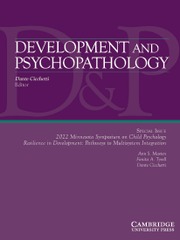Crossref Citations
This article has been cited by the following publications. This list is generated based on data provided by
Crossref.
Shaw, Daniel S.
and
Cicchetti, Dante
2019.
Honoring the Contributions and Legacy of Thomas Dishion.
Development and Psychopathology,
Vol. 31,
Issue. 5,
p.
1605.
Bedair, Khaled
Hamza, Eid Abo
and
Gladding, Samuel T.
2020.
Attachment Style, Marital Satisfaction, and Mutual Support Attachment Style in Qatar.
The Family Journal,
Vol. 28,
Issue. 3,
p.
329.
Champion, Kelly M.
and
Trane, Sarah T.
2020.
Children of Divorce amid Allegations of Violence Need Clinical Child Expertise: Adapting Empirically Supported Interventions.
Evidence-Based Practice in Child and Adolescent Mental Health,
Vol. 5,
Issue. 3,
p.
365.
Huglen, Ingeborg
Hidalgo, Waldo
Young, Melanie
and
Stokkebekk, Jan
2020.
Sterke barn i to hjem.
Fokus på familien,
Vol. 48,
Issue. 4,
p.
231.
Wang, Lin-Xin
Dou, Kai
Li, Jian-Bin
Zhang, Ming-Chen
and
Guan, Ji-Yao
2021.
The association between interparental conflict and problematic internet use among Chinese adolescents: Testing a moderated mediation model.
Computers in Human Behavior,
Vol. 122,
Issue. ,
p.
106832.
O’Hara, Karey L.
Rhodes, C. Aubrey
Wolchik, Sharlene A.
Sandler, Irwin N.
and
Yun‐Tein, Jenn
2021.
Longitudinal Effects of PostDivorce Interparental Conflict on Children’s Mental Health Problems Through Fear of Abandonment: Does Parenting Quality Play a Buffering Role?.
Child Development,
Vol. 92,
Issue. 4,
p.
1476.
Savolainen, Outi
Sormunen, Marjorita
and
Turunen, Hannele
2021.
Public health nurses’ perceptions on promotive and risk factors for children’s mental health: A qualitative interview study.
Journal of Advanced Nursing,
Vol. 77,
Issue. 12,
p.
4815.
Greenberg, Lyn R.
McNamara, Kathleen
and
Wilkins, Sarah
2021.
Science‐Based Practice and the Dangers of Overreach: Essential Concepts and Future Directions in Evidence‐Informed Practice.
Family Court Review,
Vol. 59,
Issue. 4,
p.
683.
Davis, Frank
and
Sexton, Thomas
2021.
Using the Range of Research Evidence to Help Inform Clinical Decision Making and Treatment for Family Court‐Involved Children and Families.
Family Court Review,
Vol. 59,
Issue. 4,
p.
641.
Erath, Stephen A.
and
Pettit, Gregory S.
2021.
Coping with Relationship Stress in Adolescence: A Decade in Review.
Journal of Research on Adolescence,
Vol. 31,
Issue. 4,
p.
1047.
Violanti, John M.
Mnatsakanova, Anna
Gu, Ja K.
Service, Samantha
and
Andrew, Michael E.
2021.
Adverse childhood experiences and police mental health.
Policing: An International Journal,
Vol. 44,
Issue. 6,
p.
1014.
Mashudi, Sugeng
and
Yusuf, Ah
2021.
Family Coping Strategies to Improve the Health of Family Members Living with Schizophrenia.
Jurnal Ners,
Vol. 16,
Issue. 1,
p.
67.
O'Hara, Karey L.
Wolchik, Sharlene A.
and
Sandler, Irwin N.
2021.
The Development, Evaluation, and Implementation of Parenting‐Focused Prevention Programs in Collaboration with Family Court.
Family Court Review,
Vol. 59,
Issue. 4,
p.
710.
Cao, Hongjian
Fine, Mark A.
and
Zhou, Nan
2022.
The Divorce Process and Child Adaptation Trajectory Typology (DPCATT) Model: The Shaping Role of Predivorce and Postdivorce Interparental Conflict.
Clinical Child and Family Psychology Review,
Vol. 25,
Issue. 3,
p.
500.
Gál, Martin
2022.
RODIČOVSKÝ KONFLIKT V KONTEXTE SOCIÁLNOPRÁVNEJ OCHRANY DETÍ / PARENTAL CONFLICT IN THE CONTEXT OF SOCIAL PROTECTION OF CHILDREN.
Revue of Social Sevices / Revue sociálnych služieb,
p.
29.
Dahmann, Sarah C.
Kettlewell, Nathan
and
Lam, Jack
2022.
Parental Separation and the Formation of Economic Preferences.
SSRN Electronic Journal ,
Wolchik, Sharlene A.
Sandler, Irwin N.
Winslow, Emily B.
Porter, Michele M.
and
Tein, Jenn‐Yun
2022.
Effects of an asynchronous, fully web‐based parenting‐after‐divorce program to reduce interparental conflict, increase quality of parenting and reduce children's post‐divorce behavior problems.
Family Court Review,
Vol. 60,
Issue. 3,
p.
474.
Lannoy, Séverine
Ohlsson, Henrik
Stephenson, Mallory
Kendler, Kenneth S.
Sundquist, Jan
Sundquist, Kristina
and
Edwards, Alexis C.
2022.
Risk of non‐fatal suicide attempt in individuals with substance use disorder: the roles of aggregate genetic liability and environmental exposures in a Swedish population‐based cohort.
Addiction,
Vol. 117,
Issue. 11,
p.
2943.
O′Hara, Karey L.
Boring, Jesse L.
Sandler, Irwin N.
and
Beck, Connie J.
2022.
Enhancing daily affect in youth experiencing high‐conflict parental divorce: A multiple baseline trial of an online prevention program.
Family Court Review,
Vol. 60,
Issue. 3,
p.
458.
Azizah, Yasmin
Puspitawati, Herien
and
Herawati, Tin
2022.
PENGARUH DUKUNGAN MANTAN SUAMI, STRATEGI KOPING, DAN RELASI ORANG TUA-ANAK TERHADAP KEBAHAGIAAN KELUARGA TUNGGAL .
Jurnal Ilmu Keluarga dan Konsumen,
Vol. 15,
Issue. 2,
p.
127.

